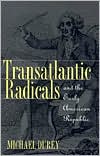

 |

|

The average rating for Transatlantic radicals and the early American Republic based on 2 reviews is 3 stars.
Review # 1 was written on 2015-08-16 00:00:00 Brian Hampton Brian HamptonNot to oversell it, but it might be impossible to truly understand American government without reading this book. "The Federalists," published in 1948, was the first of what would become Leonard White's prize-winning four-part series on the history of U.S. public administration from Washington to McKinley. I read the last one, "The Republicans," dealing with 1869-1901, a few weeks ago and enjoyed it, so I considering trying the whole set. This one, studying the early formation of US government from 1789 to 1801, is even more enlightening and informative. What White demonstrates is how thinkers like Madison, Washington, Jefferson, and Hamilton, especially Hamilton, used theory, history, and experience to construct a new federal government out of whole cloth. Instead of focusing on the supposed big issues of the era, like the XYZ Affair and the Neutrality Proclamation, White looks at how laws and regulations were created that actually allowed the government to function. For instance, how did the government collect its most important source of revenue, customs? Well Congress, in only its second act, limited the number of ports of entry so they could be more easily controlled. It then created positions of Collectors of Ports to supervise these entries and sub-officers like the surveyor of ports. Congress then required collectors to register all ships coming into or out of port depending on their size and destination, required shipmasters to declare an oath, with appropriate penalties for perjury, of their goods and manifests, and allowed some inspection of the ship by collectors (though searching dock houses or stores required a warrant from a justice of the peace). Much of this customs act and subsequent ones were designed to minimize discretion among these lower office holders, so all ad valorum taxes were created just by adding 10 or 20% to the value of the goods at the home port, and other customs were allotted by size or amount of the goods. All remissions of fines and general regulations were delegated to the very top, the Secretary of the Treasury. To further control collectors, they were required to post large bonds, up to $50,000 in some cases, and they could easily be sued, in state or federal courts, for false collections, or by the government itself for simply not doing their job well (defined as "dereliction of duty"), though failing suits required private plaintiffs to pay the collectors double costs (an effective deterrent). Few of these officers, or any others, received regular salaries, rather they received commissions and fees based on services provided, the rates of which they had to post on prominent tables, the absence of which could also be cause for suit. Perhaps this short example gives a poor account of the book, suggesting that it is concerned with merely compiling minutiae, but White puts these facts into a wider context and shows the debates in Congress and the Executive branch over what they meant. Almost any of the themes of these debates could just as easily be put into modern debates over the Obamacare law or OSHA regulations. How much discretion should federal officers have (the answer at the time was almost none, one of the only discretionary activities any officials could preform was granting permits allowing unloading of goods after taxes paid)? Can state officials carry out federal laws (after an early debate Congress decided that having federal courts everywhere would entail creating too many office-holders, a perennial concern, so they let states hear federal claims)? How much power should Congress have in its appropriation bills to control spending inside departments (not much originally, the first few appropriation bills only contained a big X amount for the year, with no division inside departments, though gradually that was narrowed)? This book thus helps show what kind of government the framers thought they were setting up (even though much of that was open to discussion and disagreement), how difficult it was, and, overall, what an admirable job they did creating something out of nothing. The book will make you look at everything that came after in a new light. |
Review # 2 was written on 2014-06-23 00:00:00 Morgana Spake Morgana SpakeThis is an excellent history of the Federalist Era at the beginning of the United States. |
CAN'T FIND WHAT YOU'RE LOOKING FOR? CLICK HERE!!!